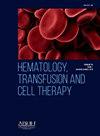Lung ultrasound score to predict development of acute chest syndrome in children with sickle cell disease
IF 1.6
Q3 HEMATOLOGY
引用次数: 0
Abstract
Objective
This study aims to identify lung ultrasound (LUS) findings associated with acute chest syndrome (ACS) at the time of admission and 24–48 h later, to compare these to chest radiography (CXR) findings and to establish a score to predict the development of this pulmonary complication in sickle cell disease (SCD) children
Methods
A prospective observational study of SCD children presenting signs or symptoms of ACS evaluated by LUS and CXR at admission and 24–48 h later. A score was conceived to predict the evolution of ACS during hospitalization based on ultrasonographic findings.
Results
Seventy-eight children were evaluated; 61 (78.2 %) developed ACS. A score greater than one at admission showed sensitivity, specificity, accuracy, and positive predictive value (PPV) of 75.4 %, 88.2 %, 78.2 %, and 95.8 %, respectively to predict ACS, while only 32 (52.5 %) CXR showed alterations. The development of ACS during hospitalization was unlikely for a score of zero and very likely for a score greater than one at admission. Regarding follow-up exams, a score greater than one showed sensitivity, specificity, accuracy, and PPV of 98.4 %, 76.5 %, 93.6 %, and 92.8 %, respectively to predict the development of ACS. ACS development was very unlikely for a score of zero and very likely for a score greater than zero in the follow-up.
Conclusion
LUS is an effective tool to assess risk for the development of ACS in SCD children with clinical suspicion.
预测镰状细胞病患儿急性胸部综合征发展的肺部超声波评分。
研究目的本研究旨在确定入院时和 24-48 小时后与急性胸部综合征(ACS)相关的肺部超声波(LUS)检查结果,将这些结果与胸部X光检查(CXR)结果进行比较,并建立预测镰状细胞病(SCD)患儿肺部并发症发展的评分方法:一项前瞻性观察研究,研究对象为入院时和 24-48 小时后出现 ACS 体征或症状的 SCD 患儿,通过 LUS 和 CXR 进行评估。根据超声波检查结果设计了一个评分标准,用于预测住院期间 ACS 的演变情况:结果:78 名儿童接受了评估,其中 61 名(78.2%)患上了 ACS。入院时评分大于 1 分的患儿预测 ACS 的敏感性、特异性、准确性和阳性预测值(PPV)分别为 75.4%、88.2%、78.2% 和 95.8%,而只有 32 名患儿(52.5%)的 CXR 出现了变化。如果入院时的评分为零,则在住院期间发生 ACS 的可能性不大;如果评分大于 1,则发生 ACS 的可能性很大。在随访检查中,得分大于 1 的患者预测发生 ACS 的敏感性、特异性、准确性和 PPV 分别为 98.4%、76.5%、93.6% 和 92.8%。在随访中,得分为零的患者发生 ACS 的可能性很小,得分大于零的患者发生 ACS 的可能性很大:结论:LUS 是评估临床可疑 SCD 儿童发生 ACS 风险的有效工具。
本文章由计算机程序翻译,如有差异,请以英文原文为准。
求助全文
约1分钟内获得全文
求助全文
来源期刊

Hematology, Transfusion and Cell Therapy
Multiple-
CiteScore
2.40
自引率
4.80%
发文量
1419
审稿时长
30 weeks
 求助内容:
求助内容: 应助结果提醒方式:
应助结果提醒方式:


